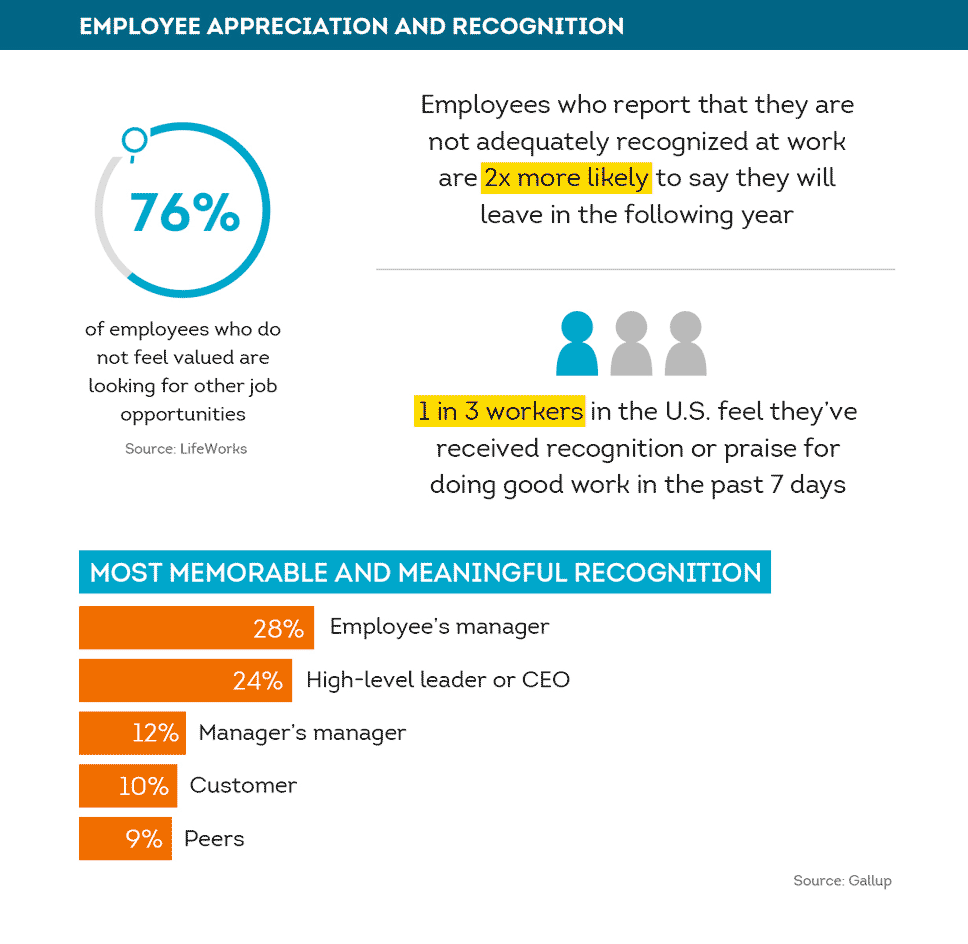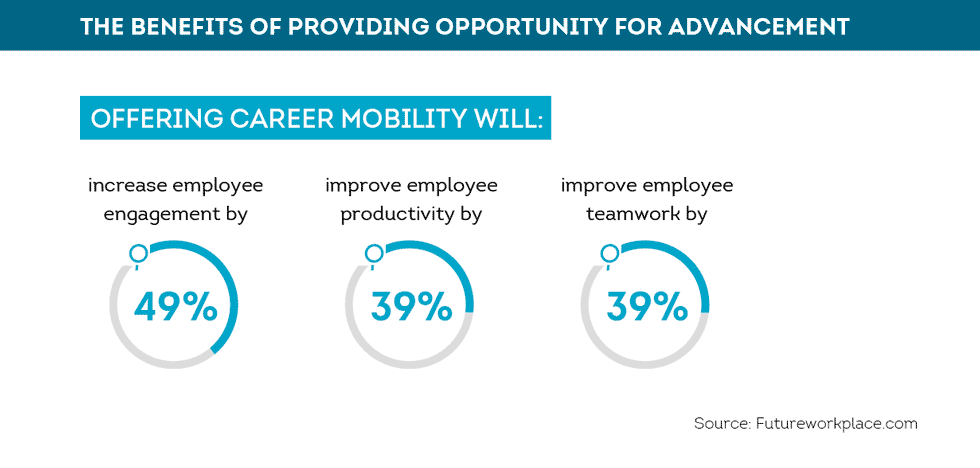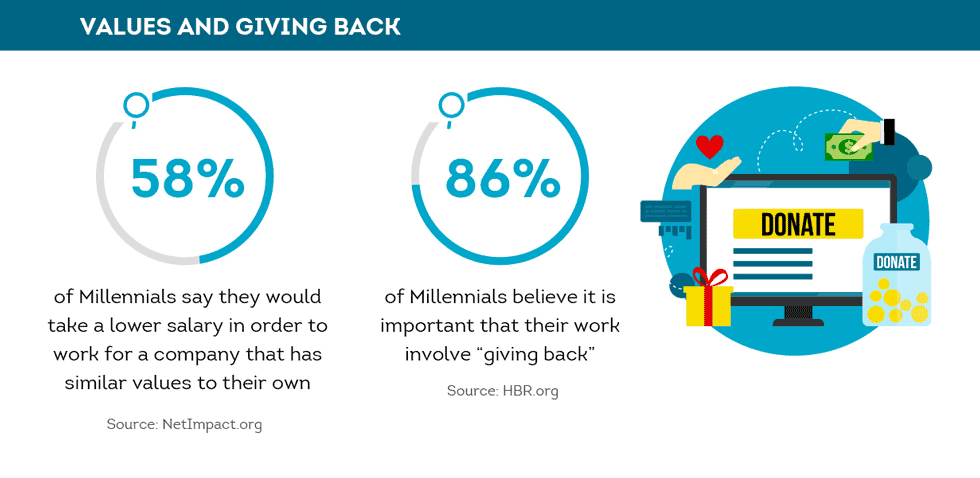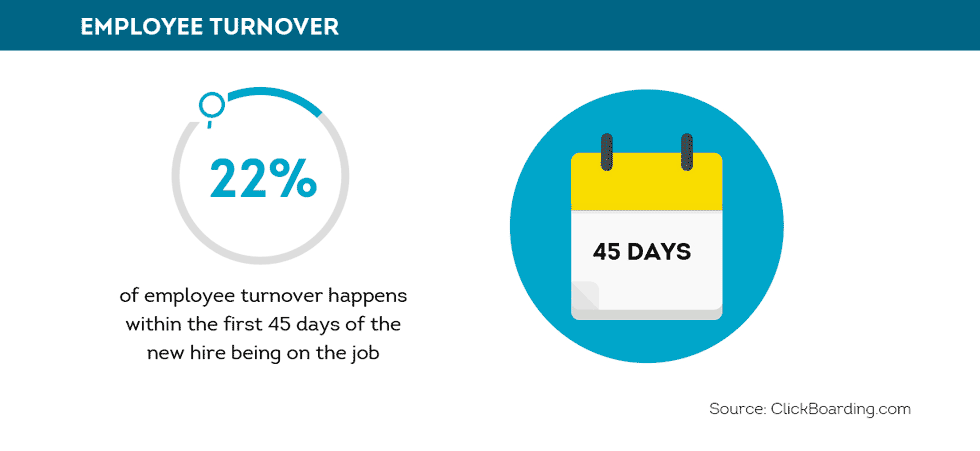Retaining your most valued employees, both new and old, is integral to running a successful business. There are many things that a small business can do to help reduce unwanted employee turnover including setting clear employee expectations, offering promotion opportunities, tracking employee performance and progress, enhancing benefits and upping compensation, offering in-office perks, and taking time to unover root causes for why employees leave in the first place.
No matter the size of your business, it’s crucial that you consistently hire reliable and motivated employees to build a strong team. But, even after you bring on solid candidates, the work isn’t over. To keep your best and brighest, an employer needs to maintain a pulse on what it needs to do keep them engaged in role.
In this article, we explore many actionable ways that a business can address employee turnover and work to retain top talent and achieve business success.
- Costs of Employee Turnover
- How To Improve Retention
- Set Clear Expectations for Employees
- Improve Employee Appreciation
- Offer Opportunity for Advancement
- Track Employee Progress and Do Check-Ins
- Enhance Compensation and Benefits
- Offer In-Office Perks
- Learn from Employee Turnover
Remember that this material is intended to provide you with helpful information and is not to be relied upon to make decisions, nor is this material intended to be or construed as legal advice. You are encouraged to consult your legal counsel for advice on your specific business operations and responsibilities under applicable law. Trademarks used in this material are the property of their respective owners and no affiliation or endorsement is implied.
Employee turnover can be extremely tough on a small business
According to a report from the Center for American Progress, turnover can cost anywhere from 16% to 213% of the lost employee’s salary. Not only is employee loss expensive, but it can also be detrimental to long- and short-term business goals and to the well-being of you and your hardworking employees.
When a good employee departs a small business, it can be a huge setback and cause many issues for everyone on the team. It’s most likely that unfinished work will be left behind and you may have to task it to other employees or do the job yourself, which is no small burden. In consequence, this extra workload could be a distraction and cause more sensitive projects to fall through the cracks.
You may also experience other business downfalls, such as:
- Productivity loss from employees
- Revenue suffrage
- Team morale burn-out
Keep in mind that losing an employee not only puts your business objectives in limbo, but it can also put your clients and customers in a strange spot, especially if your long-lost employee was their direct contact.
Ultimately, employee departure can be messy for everyone, and it’s best to try to avoid unforeseen employee turnover from the start. In order to learn how to retain employees, you need to understand why they leave companies in the first place. Unfortunately, there isn’t a single answer for why employees decide to go, as some of these reasons will be entirely out of your control. For example:
- Career changes
- Relocation
- Resigning in order to start a new chapter in their life
While it may not be uncommon for employees to leave under the above conditions, some employees may choose to leave your company for reasons that you could have prevented, such as:
- Poor management
- Limited career mobility
- Little work challenge
- Lack of overall fulfillment
Fortunately, small business owners can control these aspects for the most part. There are actions that you can take to help avoid losing the people that you need the most. Below we will discuss the best employee retention strategies so you can keep your small business employees for the long haul.
How to Improve Employee Retention
Keeping employees happy is the key to ensure that workers not only stay at your company but also are productive and invested in its success.
So, let’s take a look at happiness in the workplace. Everyone is different, of course, but Zenefits, Inc.com, and BusinessNewsDaily.com say the following can enhance employee happiness:
- Proper training and resources, so employees are well-equipped to tackle their job
- Benefits like health insurance, assisting with gym memberships or offering paid time off
- Regular, constructive feedback and reviews from management
- Rewards and incentives for excellent performance
- Clear, and achievable goals that will help the employee to advance in the company
- Good company culture
It takes hard work to make any great relationship succeed. For instance, a lack of time and attention spent on your personal relationships can spell trouble. Employee relationships aren’t any different – you need to invest in your workers if you want them to stay.
By retaining good workers, you’ll have the added benefit of keeping a vast bank of institutional knowledge and experience within the company. You can also consider filling internal vacancies with trusted employees instead of depending on unknown or unproven outsiders. But, when you do need to find outside talent, having high retention numbers to boast about can also help the company appear more attractive to potential applicants.
Maybe your industry has historically suffered from high employee turnover, and you are accustomed to losing workers periodically. For example, the hotel and service industry has high turnover rates - 73% according to the United State Bureau of Labor Statistics’ newest report. However, even if you work in a traditionally high turnover industry, such as a restaurant, it behooves you to buck this trend. High turnover can have negative effects such as potentially lowering employee morale. It also makes interpersonal relationships among employees difficult if new people are continuously added to the team as others leave.
With the average cost-per-hire at $4,129 and the average time it takes to fill in a vacant role at 42 days, it makes sense (and cents) to provide a good working environment for your employees to avoid the expensive hassle of finding new hires.

Set Clear Expectations for Employees
Imagine that you just started a new job and you are eager to make a great impression. Your supervisor assigned you a “project” and assured you that you’d find it challenging and enjoyable. Then, the boss handed you a large box containing a disassembled desk. The task was to build the desk.
But you were not given any assembly instructions. You weren’t given any guidance. The supervisor not only failed to give you directions but also didn’t tell you that you would also be judged on the speed at which you built the desk. You were merely told to build it without any context.
Employees may feel lost and incapable if you don’t give them a clear list of expectations about what, how, and why they should complete particular tasks as part of their job. You might be surprised to learn that up to 50% of workers feel they don’t understand the expectations for their role.

Things you can do to set clear expectations for your team:
Set and reevaluate work priorities: Be clear about what projects are most important and focus the employee’s effort on that work first. Rejigger priorities as things change. It could be helpful to set weekly meetings to talk over priorities and ensure alignment.
Establish when deliverables are needed: Be upfront about when work is due. If need be, then set up a calendar that spells out what work is due and guidance on quality.
Set attainable and measurable goals: Create goals and milestones for your employee that ladder back to your company’s overall strategy. Make the goals understandable, achievable, and measurable so that both you and the employee can easily track their progress.
Improve Employee Appreciation and Recognition
According to Forbes, 66% of employees said they would quit if they feel underappreciated. What can a small business do to genuinely show that they value their employees?
If you want to improve employee retention rates, it’s especially important to celebrate yearly anniversaries and milestones. According to Harvard Business Review (HBR), most workers who change jobs did so in the first year. In their study of over 1 million people, they found that resignations tend to spike around work anniversaries. Why does it work out this way? HBR states that it could be a result of contract timelines or even just the psychological appeal of round numbers. Regardless of the reason why employees tend to leave around work anniversaries, it seems like a small business should consider carving out time formally to acknowledge a work anniversary as a tactic to improve retention.
Some forums to acknowledge work anniversaries include:
- Sending an email announcement to the company
- Congratulating anniversaries in a town hall meeting
- Having a formal or informal party to celebrate an anniversary
In addition to honoring work anniversaries, you should consider rewarding employees for going above and beyond. This is a useful and beneficial employee retention technique, no matter the position. When an employee does something exceptional for the company, be sure to take the opportunity to acknowledge it publicly. This not only gives a supervisor a platform to properly give credit to the outstanding individual but also signals to others at the company that hard work and great results don’t go unnoticed. Also, where appropriate, consider giving tangible awards as a sign of appreciation.
Pro-Tip: As you consider how to retain employees, look to individually recognize team members instead of continually celebrating the entire group with outings. If everyone from the top performers to the unpaid intern gets the same reward, it could lose meaning for the best workers who deserve acknowledgment and/or rewards.

Offer Employees the Opportunity for Advancement
One of the best employee retention strategies is developing a path for career growth and promotion. In practice, this isn’t always easy to do. Perhaps the next rung on the career ladder is a director position, but that role is already filled on the team. Even in such a situation, you can still provide some alternatives that offer upward mobility.
If the path to advancement is muddled or dependent on other employee career movements, then you can give your strong performers more responsibilities now as an avenue to grow their career. They can get additional experience, learn new skills and derive more job satisfaction. As they thrive while handling more load, then they set themselves up for promotion and better pay a little later down the line.
You might also set aside a budget you can use to send your best employees to conferences, seminars, or workshops to invest in their professional development. Not only does this give them tangible new skills, but also signals that you want to invest in them. It shows hardworking employees that you want to develop their skillset because you see them as a key player on the team.
Finally, take the time to become their mentor. Career mentorship is a great way to get your stellar employee more involved in the company and invested in the future. Explain to your stellar employee that they are special and that you are going to devote your time and energy to guide their career path. You can talk to them about their ultimate career goals and how the company can help get them there.

Track Employee Progress and Check In
It’s a good idea to schedule regular one-on-one meetings with your employees to build in time to keep the lines of communication flowing. This is a good time to put away your cell phone, turn off your computer, and focus on your employee.
- You can use this time to:
- Plan work in the future
- Stay abreast of project progress
- Discuss any current challenges
- Review accomplishments
- Refine goals
One-on-ones are also a great time to offer help where you can. If your employee is struggling and asks for assistance, then roll up your sleeves and work together to solve a problem that they are facing. Whiteboard out solutions. Give them options to pursue. Talk through ways to attack the problem. If needed, then schedule follow-up meetings to make progress. The main idea is to let them know that you are available to help and that they can rely on you to help them make progress.
Also, don’t be afraid to learn more about your employees’ outside hobbies to help foster a better work-life balance. Do they like to fish? Play the guitar? Cook? Becoming familiar with their free-time hobbies can help break up work-only chatter and make develop a more high-functioning (and personal) relationship.
It can also be beneficial to have “stay” interviews (the opposite of exit interviews) as a way to get an employee’s feelings and perceptions about their role and performance. By asking strategic questions, you can address and resolve issues.
Here are some questions to ask:
- Why did you choose to work here?
- What do you like about our company?
- What are your non-negotiable must-haves when it comes to the job?
- What would you change or improve when it comes to your role?
- What would you change or upgrade when it comes to the company?
Enhance Compensation and Benefits
Sure, you don’t necessarily want an employee who is only motivated by a dollar amount. But, providing a fair salary or hourly pay that’s commensurate with experience and value created is a huge factor in terms of retaining employees and attracting qualified new ones.
It’s crucial to audit salaries regularly so that they reflect market conditions. If you are “under market” for salary, then you might consider adjusting pay. Also, be sure to figure out total compensation for your employees and communicate it to them. Salary, while incredibly important, isn’t the only compensation factor. If you offer a competitive salary along with fantastic benefits, then be sure to highlight the total cash compensation to your employees. It is possible that your employees may not be familiar with all of the components of pay (bonus, paid time off, 401k matching, low copays, etc…) and not fully understand their overall compensation
Along with good pay, benefits packages are another way to retain your top talent (as well as attract high-quality hires). Good benefits are important because they can provide employees access to resources that they might not otherwise be able to afford. Plus, on the business end, you might gain some tax advantages.
Here are some of the top benefits that draw in employees and keep them:
- Health insurance
- Vacation and paid time off
- Retirement plan or 401k plan
- Dental insurance
- Maternity and paternity leave
- Paid sick days
- Vision insurance
- Paid holidays
Benefits can increase overall employee productivity. In 2004, Netflix made headlines for their policy of unlimited vacation time – often called “flex time off” or FTO. The idea behind that unlimited time off is that it encourages employees to manage when and how much time they take off. Unlimited time off gives workers a sense of independence and the ability to decide what is in their best interests in consideration of the company as a whole. While you don’t have to go to this extreme, it’s something to keep in mind when you’re thinking about the type and extent of the benefits you offer.

Consider Company Culture
Company culture is a huge part of why employees stay with their current company or move on. One of the most significant elements of good company culture is the concept of transparency.
Transparency gives employees the ability to see more plainly how the company runs and where it’s going. Above all, it instills trust. In fact, strong transparency from the management team can lead to 30% better employee retention.
There are many ways to facilitate trust and transparency when it comes to your business. One way is to use different communication tools like Slack or Yammer so employees can be easily kept up to date and communicate easily with one another. Tools like Trello or Asana are collaborative project management tools that can facilitate interdepartmental teamwork and keep employees accountable and organized with their work and future workloads.
Sharing company successes with other employees is another way to add positive vibes. Team wins are a great way to boost morale because it’s a direct result of dedication and hard work.
In the interest of transparency and trust, it’s also vital to share company challenges. You hired your team for a reason, and they can help you think of out-of-the-box solutions.

Offer In-Office Perks
Another retention tool in your toolbox is to offer perks that your employees highly desire. These kinds of perks can be quite meaningful for workers and often times cost the company very little, such as occasionally allowing four-legged friends in the office.
To keep your employees happy (and caffeinated), consider putting in a nice coffee machine stocked with gourmet beans. It will cost you a little more, but it will likely be noticed and appreciated by your team. Plus, you might keep everyone more productive by keeping the Starbucks runs to a minimum (sorry, Starbucks).
If your office culture supports it, you may consider a foosball or air hockey table. These games aren’t very expensive and can create some nice bonding opportunities. Small game centers can give employees a place to go to debrief from work for 10-15 minutes without actually leaving the workplace.
Another in-office perk to consider is to set up a regular “lunch and learn” series, which can benefit everyone. Employers can devote time to imparting new knowledge or skills to help bolster productivity, while workers get to enjoy a free bag lunch from time to time.
Encourage workers to move during the day by offering them a free gym membership or an in-office gym for convenience. Make sure they know that their health is something you value and that you support an active lifestyle. A wellness program not only encourages your employees to think about their well-being, but also can reduce the number of sick days taken, enhance employee focus, and in the end, cost you less overall.
Pro-Tip: Maybe you can even find a way to encourage gym time by hosting a fun competition between employees or different departments.
Company happy hours are another nice perk to get people to socialize outside of the office work environment and build inter-departmental connections. Cultivating relationships among employees can help to foster friendship, goodwill, and a sense of camaraderie. If an employee feels part of a team, they may be happier to come to the office and produce better quality work.
Consider Your Values and Give Back
If you’re working for a company whose ethos isn’t aligned with your personal values, then you might feel less invested and interested in your work over time. Sometimes, employees will leave a company because they feel like their values don’t match up with their company’s culture.
You can help prevent this as an employer by using a careful hiring process that doesn’t just focus on skills and accolades, but character as well.
Giving back is a great way to get your employees involved in your company and to spread goodwill. Encourage your employees to get involved in charities and ideally, make it include a team-building aspect.
For some examples:
- Invite the entire office to participate in a charity walk
- Sign up with a group such as Habitat for Humanity
- Volunteer at a soup kitchen for an afternoon
- Offer a donation-match program

Learn from Employee Turnover
Inevitably, certain employees will leave your company and it’s a good idea to implement an exit interview before their departure. The purpose is to get a better understanding of why they’re leaving. By taking detailed notes and keeping those answers in mind, you can begin to find ways to help minimize attrition in the future.
Pro tip: You don’t have to wait for an exit interview to get feedback. Consider asking these questions during an employee review to uncover any issues that could lead your star performer to seek a job elsewhere.
Sample exit interview questions to ask an employee who is resigning:
- Were there conditions or any incidents at the company that prompted you to start looking for a new job?
- What reasons did you have for finding a new job? Salary? Benefits? Time off?
- Is there a benefit you think the company could offer employees in the future?
- Did you feel like you received adequate training to succeed in your position? If not, how would you change training procedures?
- Were you given the resources and tools necessary to accomplish your job from the start?
- Were there any policies established by the company that you didn’t agree with or found difficult to comprehend?
- Did your role reflect the initial job description accurately? Did it change at any time during your employment? What did you like most about your current position?
- What did you like the least about your role?
- Were there any significant challenges that came up with your specific job? How could the company have helped to make those challenges more approachable?
- How could the current role be improved or changed?
- Did you feel like you had enough support during your employment?
- What did you think about the manager or supervisory feedback in regards to your job? Do you have any concerns about the company you’d like to share?
- Would you recommend others to work for this company?
- Do you have any other suggestions or comments?

Final Notes
Jim Collins, author of Good to Great, talks about “getting the right people on the bus” as one of the most important things a business can do to thrive. Along with that, retaining your top talent is vital in order to achieve success for your business.
Attrition can be not only harmful to office morale and culture, but ruinous from a bottom-line perspective. While it’s impossible to retain everyone, small business owners should implement employee retention techniques to develop a highly desirable workplace where your employees will want to remain a part of your team for a long time. By implementing a path to career growth, providing premier benefits, celebrating performance, instilling office perks, and paying competitively, small business owners have many options at their disposal to improve retention rates and office morale.
Here are a few main reasons to improve employee retention:
- Better company productivity levels
- Better service levels for customers
- Better overall office morale
- Reduced recruiting costs – the cost to replace a highly trained employee can be 200% of salary
- Reduced training outlays
- Reduced number of industry-specific errors
No matter how new your business is to your industry, you need hardworking employees who know the ins and outs of the company and are as passionate as you are about the success of the business. It’s integral to long-term success to learn how to retain employees. It can be challenging to deal with frequent employee turnover, lack of employee motivation and dedication, and the expense of hiring and onboarding a new hire too often. For a small business, it’s mandatory that all hands are on deck all the time. That said, it’s in your best interest to use employee retention techniques that keep top talent at your company—and provide them with reasons to stay other than a paycheck.
Your small business relies on the work and dedication of great employees. By conducting pre-employment screening before officially hiring someone onto your team, you are saving yourself and your already hard-earned employees a great deal of time and, in the end, money. From hosting an initial phone interview to making your final hiring decision, it’s important to look for key indicators of a great candidate and watch out for red flags such as a criminal record or poor credit history.
TransUnion ShareAble for Hires offers comprehensive, FCRA approved credit and background check reports. While creating an effective hiring process can be a long, daunting task, ShareAble for Hires gives small business owners the convenience of screening their prospective hire all online and they will receive the reports they need in a matter of minutes. The minimal cost of an employment background check may prove to be well worth the investment if your company gains a stellar employee.
So, don’t wait around! Start implementing a new employee retention strategy today and ensure you are hiring the best employees from the start with ShareAble for Hires.




